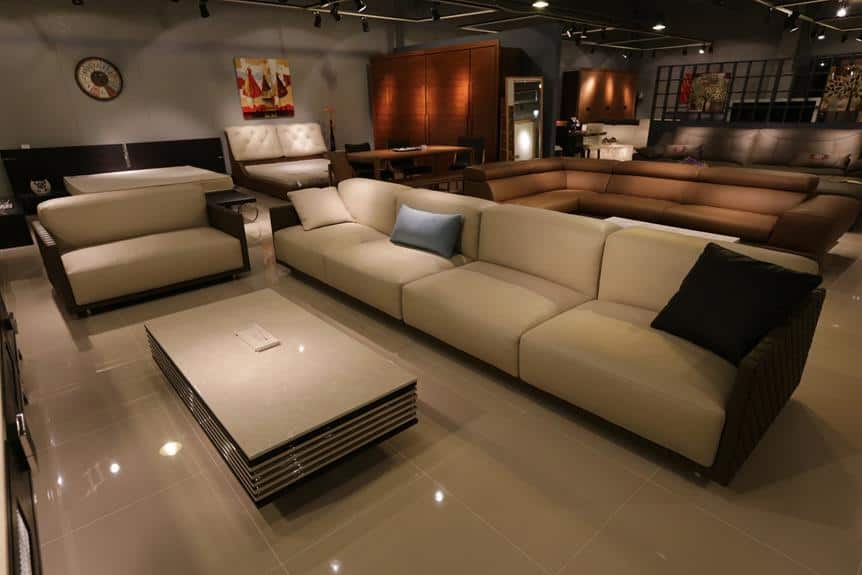Floating furniture involves positioning it away from walls to make the living room seem more spacious and dynamic. The layout should be planned around a central feature, such as a fireplace or window.
Balance, the size of furniture, and the ability to move around easily are important to consider for an effective arrangement. Using area rugs and spacing furniture appropriately helps create a unified look that facilitates conversation.
Properly floated furniture can make the living room more welcoming and adaptable.
Understanding Floating Furniture
Floating furniture involves positioning sofas, chairs, and tables away from walls to create separate areas in a large space. This approach is common in modern interior design to make living spaces more versatile. Moving furniture from the wall changes the room's aesthetic and functionality, creating visual divisions for different activities such as socializing or working.
The placement of furniture in the center of a room should be deliberate, taking into account how people will move through the area. For instance, a centrally placed sofa in a living room can foster a cozy atmosphere for conversations, similar to hotel lobbies. The arrangement appears intentional, and the space feels more welcoming.
Floating furniture also allows for complete visibility and access to each item, enhancing the overall flow and making the room seem larger and more open. It prevents the area from feeling overcrowded by establishing clear paths for movement, which is particularly useful in open-concept homes without walls to define spaces.
The Benefits of Floating
Floating furniture in a living room provides three main benefits:
- It makes the space appear larger
- It improves the flow of movement
- It creates distinct functional areas without using walls.
Furniture placed away from room edges gives the impression of a larger area, which is particularly useful in small spaces.
Interior designers recommend floating arrangements to allow more walking space and create a comfortable environment. This placement enhances movement within the room and is helpful during social events.
Also, floating furniture can visually divide a room into different areas, which is ideal for open-plan spaces. It allows for the creation of a cozy conversation area without blocking light or views.
Planning Your Layout
To plan your living room layout, first measure the space and furniture size for a functional setup. Use floating furniture away from walls to create a modern look, but make sure it fits well in your room to avoid overcrowding.
Draw a floor plan, noting doors and windows for clear walkways. Choose furniture that matches the room's size; large items can crowd a small space, and small items can look out of place in a large space. Place the largest items near a focal point like a fireplace or window to center the room.
Ensure there is enough space between furniture for a spacious feel and movement. Use rugs to define areas and add texture while protecting floors from heavy furniture.
Try different furniture arrangements, possibly with visualization tools, to find the best combination of style and function for a welcoming and attractive living room.
Furniture Arrangement Tips
When planning your living room, consider positioning your sofa away from the wall to create a dynamic and intimate area for conversation. Ensure visual balance by using a coffee table or rug to anchor the sofa and define the space. This strategy helps to create separate zones in a larger room while keeping an open feel.
In smaller rooms, placing furniture away from walls can make the space seem larger by creating the illusion of more room. Although it might seem odd, this method is effective in reducing the cramped feel of tight spaces.
For a well-arranged room, it's important to consider the size and scale of your furniture. Opt for pieces with visible legs and smaller sizes to make the room look more spacious, as they don't block views or light.
Using the space behind floating furniture for decoration or storage, such as with a console table, bookshelf, or art display, can also enhance your living room's decor.
Following these tips will help you achieve a functional and attractive living room setup.
Common Floating Mistakes
A common error when floating furniture is not accounting for the room's traffic flow. This oversight can result in blockages and a layout that doesn't work well. Furniture should not be placed too far from the walls without considering movement in the room, as this can make the space feel unwelcoming. There should be ample space for people to move comfortably around the room.
In rooms such as family areas, avoid using overly large or heavy furniture, which can make the space feel crowded. Opt for pieces with slim frames and legs to create a more open feel. Furniture should also be positioned to facilitate easy conversation, without people having to raise their voices to speak to one another.
Diagonal placement of furniture can add visual interest but should be done with round-edged items to maintain flow. The space around tables must be sufficient for movement, and furniture should not block common walkways.
Careful floating of furniture can make a living room look and function better.




